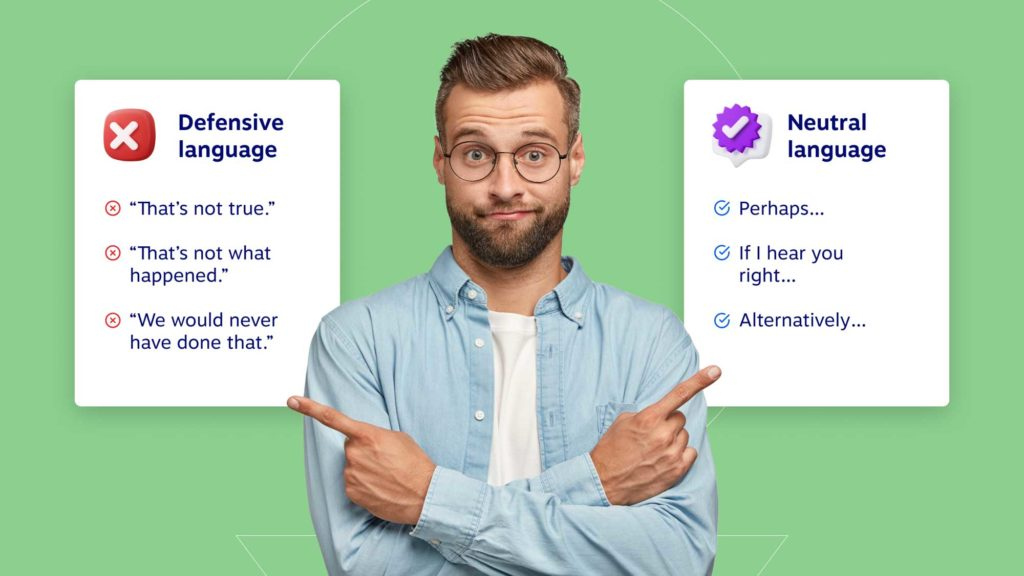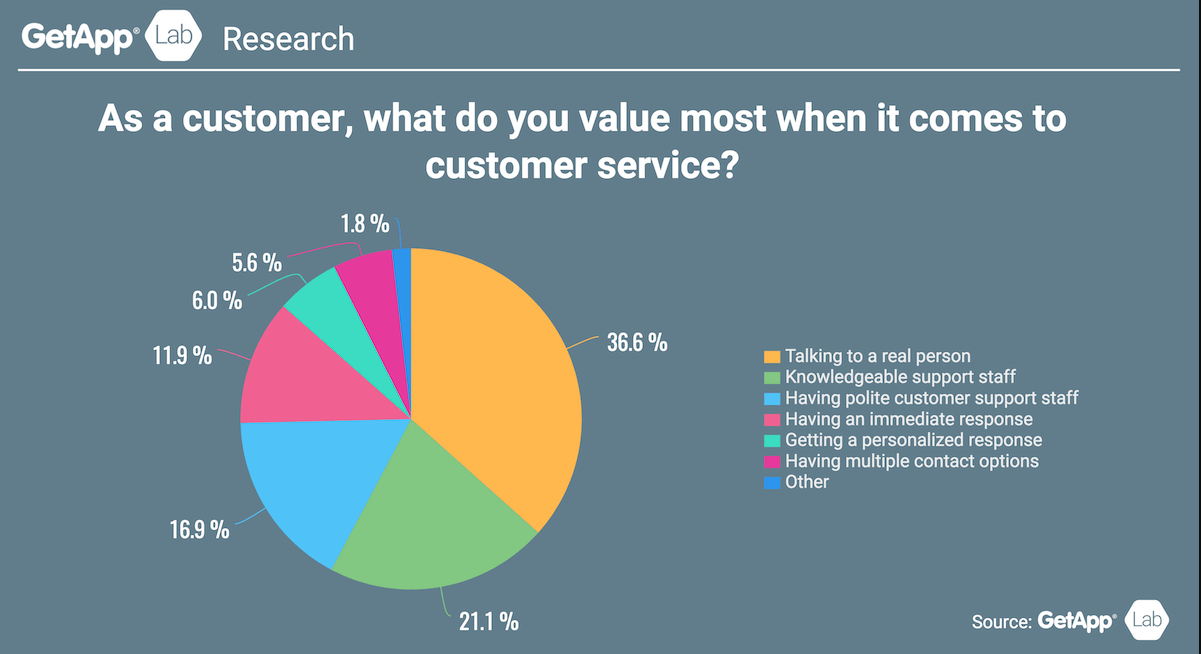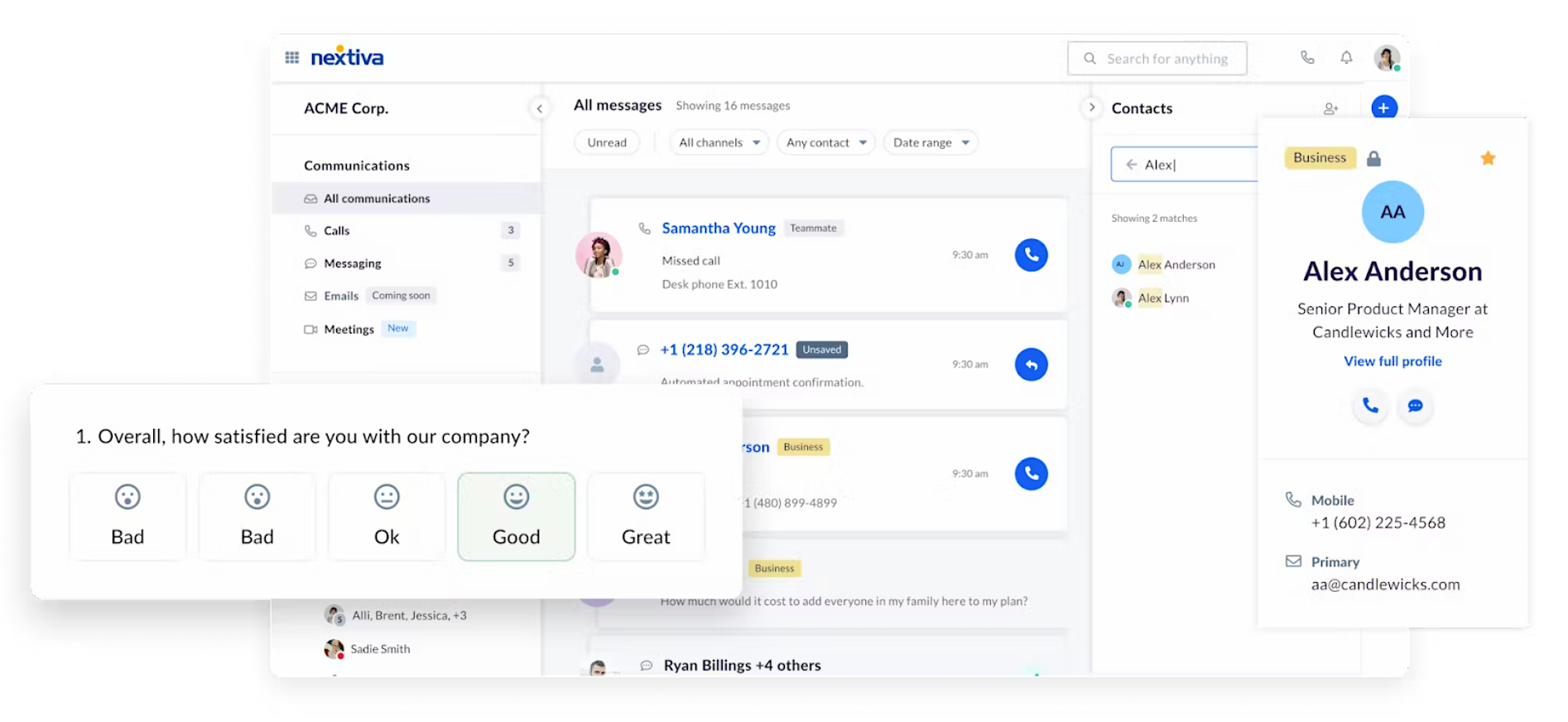Let’s face it, dealing with difficult customers is inevitable in a customer service role. Whether it’s an angry outburst, a rude comment, or endless indecisiveness, these situations can test your patience and professionalism.
But the good news is, with the right approach, you can not only de-escalate the situation but also find a solution that leaves the customer feeling heard and valued.
In this article, we’ll discuss different types of difficult customers you may come across, explore key strategies to deal with difficult customer situations and find a resolution that leaves everyone feeling good.
Types of Difficult Customers
1. The angry or rude customer
Angry customers are impatient, disrespectful, and prone to outbursts. They might yell, use abusive language, or make personal attacks when things don’t go their way.
Example: A customer waiting in an IVR queue yells at the customer service agent about the slow service.
Some ways you can deal with them:
- Stay calm: Don’t react defensively or take their anger personally. Take a deep breath and project a calm demeanor.
- Acknowledge their feelings: Say something like, “I understand you’re frustrated about the wait. I apologize for the inconvenience.”
- Focus on conflict resolution: Shift the conversation toward problem-solving. “Is there anything I can do to help expedite this for you?”
- Set boundaries: If the abuse continues, politely but firmly excuse yourself and explain you’ll return when they can speak calmly.
2. The demanding customer
These customers have unreasonably high expectations and make demands that exceed company policies. They might insist on special treatment or exceptions not offered to others.
Example: A customer demands a full refund for a slightly used item they bought a month ago, even though the store’s policy only allows returns within two weeks.
How to deal with them:
- Be polite but firm: Explain company policies clearly and professionally. “I understand your frustration, but unfortunately, our return policy only allows refunds within 14 days of purchase with a receipt.”
- Offer alternatives: See if there’s a solution within company policy. “Would you be interested in store credit instead?”
- De-escalate: If they persist, explain you need to follow company guidelines and offer to escalate the situation to a supervisor.
3. The indecisive customer
Indecisive customers struggle to make decisions or provide clear instructions. They might constantly change their mind or take a long time to choose.
Example: A customer browsing a clothing store keeps going back and forth between two different shirts, unsure of which one to buy.
Here are some ways to deal with them:
- Be patient: Don’t rush them or seem annoyed.
- Ask clarifying questions: “What are you looking for in a shirt?”
- Offer product knowledge: Highlight features of each option based on their needs. “This shirt is wrinkle-resistant, while this one is more breathable.”
- Summarize options: “So, you seem to prefer the blue shirt for its color, but are unsure about the fit compared to the looser white one?”
- Confirm decision: Once they lean towards an option, confirm before proceeding. “Great, so the blue shirt in medium sounds perfect?”
4. The complainer
These customers frequently voice complaints, even after their issues have been addressed and resolved according to company policies. They may nitpick or find new things to complain about, making it challenging to fully satisfy them.
Example: A customer complains about a slight imperfection in their product, and after receiving a replacement, they complain about the packaging or shipping time.
How to deal with customer complaints:
- Document everything: Keep detailed notes of each interaction.
- Follow procedures: Address their complaints according to company policy.
- Maintain professionalism: Be helpful and solution-oriented, but don’t engage in arguments.
- Set boundaries: For repeat, unfounded complaints, politely explain you’ve addressed their concerns and cannot offer further compensation.
5. The price-sensitive customer
These customers are primarily focused on getting the lowest possible price and may try to haggle or demand discounts beyond what is reasonable.
Example: A customer tries to negotiate a 50% discount on a new TV that’s already on sale.
Dealing with such customers:
- Know your limits: Be clear on what discounts you can offer.
- Highlight value: Explain the product’s features and benefits to justify the price.
- Offer alternatives: Suggest similar products with lower price points if available.
- Stick to your price: Politely decline unreasonable requests and explain the current price is the best you can offer.
6. The unresponsive customer
Unresponsive and uncommunicative customers fail to provide necessary information or respond to requests for clarification. This can significantly delay the service or resolution process.
Example: A customer doesn’t reply to emails requesting information needed to process their service request.
How to deal with them:
- Multi-channel communication: Use a combination of communication methods like email, phone calls, and even text messages (if appropriate) to reach them.
- Set deadlines: Clearly communicate deadlines for responses and outline the consequences of non-communication (e.g., service suspension).
- Offer alternatives: Provide options for preferred communication channels if email isn’t their preferred method.
Understanding the Why Behind Difficult Behavior
Difficult customers come in all shapes and sizes. While their behavior can be frustrating, it’s important to remember there’s often a reason behind it.
Maybe they’ve had a bad experience with your company before, or perhaps their frustration stems from a genuine issue that hasn’t been addressed.
Some customers may be dealing with personal challenges or circumstances you’re unaware of, which could contribute to their behavior. Extending a little compassion and understanding can go a long way in turning a difficult situation into a positive one.
Approach difficult customers with empathy, actively listen to their concerns, and work together to find a resolution. You’ll not only resolve the immediate issue but also foster stronger, more positive customer relationships.

How To Deal With Difficult Customer Situations
1. Embrace active listening
Sometimes, the best course of action is to simply let the customer vent. Listen attentively without interrupting, and focus on understanding the root cause of their frustration.
This doesn’t mean accepting abuse — it means staying calm and collected while they express their concerns. Once they’ve finished venting, paraphrase their issue to confirm your understanding.
Active listening is a powerful tool. It shows the customer you’re taking them seriously and helps build rapport.
Here’s a simple technique: After they finish speaking, try saying, “What I hear you say is…” followed by a summary of their problem. Once they confirm that’s accurate, you can move forward.
2. Maintain your calm
It’s easy to get flustered when faced with a customer’s anger. But remember, their frustration is likely directed at the situation, not you. Don’t take it personally.
Respond with confidence and calmness. Avoid phrases like “I’m sorry for the inconvenience” — these don’t address the core issue. Project a calm body language and maintain eye contact in a customer-facing situation.
Staying calm has several benefits. It helps you focus on finding a solution instead of getting caught up in the emotions. It also makes it easier to find common ground and build trust with the customer. Plus, a calm demeanor prevents the customer from getting even more upset.
Developing strong conflict resolution abilities is crucial for customer service professionals to navigate difficult situations and find mutually agreeable solutions effectively.
The customer support team should be well-versed in various conflict resolution techniques to defuse tensions and ensure a positive outcome when dealing with challenging customer interactions. And calmness sits at the top.
3. Empower with options
Once you understand the problem, it’s time to explore solutions. Don’t just present a single option — offer the customer a few choices for resolving their issue. This empowers them and gives them a sense of control, reducing their frustration.
For example, if a customer is unhappy with a product malfunction, you could offer a replacement, a refund, or a store credit. Let them choose the solution that best suits their needs.

Remember, there’s almost always something you can do, even if it’s just taking detailed notes and sharing them with your product team or management. Often, frustrated customers simply want to feel heard and know their concerns are being addressed.
4. Be genuine and show empathy
When faced with an irate customer, the first step is to carefully understand the customer’s problem from their point of view, which requires active listening and empathy — two key customer service skills.
Put yourself in the customer’s shoes and try to understand how they feel. Empathy is a powerful tool for building customer loyalty. Loyal customers are responsible for a whopping 65% of a company’s revenue.
Be sincere in your interactions, even when explaining limitations. Honesty is always appreciated. Let them know their concerns are heard and explain how their feedback can help prevent similar issues in the future.
5. Use humor carefully
Humor can be a powerful tool for diffusing tense situations with customers, but it needs to be used carefully. Only attempt humor if you’re comfortable with it and the situation seems appropriate. Don’t try to be funny if the customer is extremely angry or upset — it may backfire.
The key is to keep any humor light and positive. Avoid sarcasm or jokes that could come across as offensive. Be sure to read the customer’s reaction. If they don’t seem receptive, drop the humor immediately.
When used correctly, a bit of levity can help put the customer at ease and make the interaction feel more positive overall. But use discretion — not every situation calls for jokes.
6. Maintain a consistent channel & automate
Imagine being halfway through explaining your problem on the phone, only to be told to switch to email or chat. Frustrating, right? Avoid switching communication channels (phone, email, chat) throughout the interaction. This creates friction and makes the customer repeat.
Invest in a unified communications solution if possible. This allows your team to seamlessly support customers across different channels. They can see all past interactions and customer information in one place, while the customer gets to choose their preferred communication method.

Automate some of your workflows (where possible). Use self-service options to help customers find information on their own and chatbots to answer regular customer queries.
You can also invest in a conversational IVR to connect your customers easily to your contact center team without waiting in long queues.
Automation saves your time and deals with everyday customer situations. When customers can easily connect with you or discover answers to their problems, they’re less likely to get frustrated or churn.
7. Use de-escalation techniques
The situation might call for additional techniques to calm a particularly upset customer:
- Mirroring: Briefly repeat back key phrases or words the customer uses to acknowledge their feelings. This can help validate their emotions and calm them down.
- Use “I” Statements: Instead of blaming the customer, use “I” statements to take ownership of the situation. For example, “I understand why you’re upset, and I apologize for the inconvenience.”
- Offer Apologies Sincerely: Even if the situation isn’t entirely your fault, a sincere apology can go a long way in de-escalating a situation.
8. Teamwork makes the dream work
If the situation gets complex or requires specialized knowledge, don’t hesitate to involve your support team or product experts. The key is to find a solution quickly and efficiently.
Involve the customer in the process as much as possible, keeping them informed. Use chat tools to connect with team members or product experts while relaying information. If you need to share knowledge base articles, explain their relevance and why they’re helpful.
Remember, some customers might be new to your product. Explain information in multiple ways, including visuals like videos or annotated images, to increase understanding and customer satisfaction.
9. Don’t forget self-care
Dealing with difficult customers day in and day out can be mentally draining. That’s why it’s crucial to practice self-care techniques that help you de-stress and recharge.
Schedule short breaks throughout your shift to step away from the phone. Practice positive self-talk to counter any negativity from challenging situations. Develop healthy relaxation techniques like deep breathing or meditation to manage stress.
And don’t be afraid to lean on your support system. Talk to colleagues or friends about particularly difficult customer encounters or bad days. Sometimes just venting can help relieve tension.

Example of a Customer Service Script To Use With Difficult Customers
Here’s an example of a difficult customer interaction and how to handle it.
Type of difficult customer: The demanding customer
Scenario: A customer calls in demanding a full refund for a product they bought a month ago, claiming it arrived damaged. However, the company’s policy only allows returns within two weeks for unopened items.
Customer: “I received this product a month ago and it’s completely damaged! I want a full refund now!”
Customer service representative (CSR): “I understand how frustrating that must be. Can I get your order number and some details about the damage?” (Calm and professional tone)
Customer: “My order number is #12345. This thing is in pieces! You should have better packaging.” (Angry tone)
CSR: “I apologize for the inconvenience. Our policy allows for returns of unopened items within two weeks of purchase. However, I can see if there are other options available. Would you be interested in a replacement or store credit?” (Acknowledge their frustration and offer solutions within policy)
Check out some more script templates here.👇
Know When To Involve a Manager
There are times when it’s in everyone’s best interest to involve your manager or business owner. Here are some key situations:
- Threats or verbal abuse: If a customer becomes threatening or verbally abusive toward you or others, don’t hesitate to step away and involve your supervisor. Your safety is paramount.
- Safety concerns: If a customer becomes disruptive or damages property, escalate the situation to your manager immediately.
- Policy exceptions: If a customer’s request requires a policy exception that you’re not authorized to make, explain the limitations of your role and involve your manager to discuss possible solutions.
- Going in circles: If you’ve reached an impasse and are unable to resolve the issue despite your best efforts, loop in your manager to provide a fresh perspective and potentially more authority to reach a solution.
- Uncomfortable situations: If an unhappy customer makes inappropriate comments or expresses discriminatory views, remove yourself from the situation and involve your manager to handle it appropriately.
The Power of Delightful Service
Great customer service requires equally great efforts and investment in your customer success.
Difficult customers can be an opportunity to shine. With excellent customer service and going the extra mile, you can turn a negative customer experience into a positive one. Remember, most customers simply want to get things done — they have goals and lives outside of interacting with you.
Focus on being genuinely helpful in every customer interaction. Your mission is to make their day a little bit better, even if it’s just replying to a follow-up email with a clear solution. Following these steps can deliver exceptional service and leave a lasting positive impression, even on your most challenging days.
There’s no magic formula for dealing with difficult people, but treating them respectfully and understanding their needs.
Learn from a real-world example. See how Rack Attack is driving customer service excellence with Nextiva.





